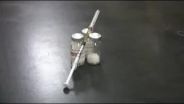The ends count starting at birth
Newborns use first and last syllables to recognize words
2015-07-21
(Press-News.org) Most of us think of infants as tiny beings whose main business is to sleep, suck and cry, without much awareness of what is happening around them. It may come as somewhat of a surprise, then, to know that newborn brains are full of feverish activity and that they are already gathering and processing important information from the world around them. At just two days after birth, babies are already able to process language using processes similar to those of adults. SISSA researchers have demonstrated that they are sensitive to the most important parts of words, the edges, a cognitive mechanism which has been repeatedly observed in older children and adults.
It is well-known that, in general, people better remember the edges of sequences and particularly in language, when we must remember and recognize words, the brain gives greater weight to information at the beginning and the end of the word. Languages around the world seem to capitalize on this better encoding at the edges. "The syllables at the beginnings and the ends of words often carry important information. For example, the parts of words that contain information about plurality of objects or verb tense are almost always found at the beginning or at the end of words in all known languages," says Alissa Ferry, researcher at the International School for Advanced Studies of Trieste (SISSA) and author of the study.
"It is a pervasive phenomenon and our study shows that it is present from birth," says Ana Flo, a SISSA researcher who was involved in the study. "Here at SISSA researchers already showed that pre-linguistic babies of 7-8 months show this enhanced encoding of word edges, but we went further, showing that this mechanism is present in humans even during the first days of life."
"The infants heard a sequence of six syllables and we examined if they could discriminate it from a very similar sequence, in which we switched the positions of two of the syllables. When we switched the edge syllables, the newborns' brain responded to the change, but when we switched the two syllables in the middle, they did not respond to the change. This suggests that the newborns better encoded the syllables at the edges of the sequence," says Perrine Brusini, a SISSA researcher and one of the study's authors.
In real language there are signals, like prosody or very subtle pauses, that cue the boundaries between words and phrases, and may help us remember words from even longer discourse. "In another series of experiments, we tried to find out if neonates can use these cues to process the syllables in the middle of the sequence," continues Flo. "To do that we introduced a small discontinuity between the two middle syllables, an almost imperceptible 25millisecond pause, and examined whether infants would now notice the switch between the middle syllables. With this very subtle cue, the neonate brain treated the sequence as two shorter words and responded when the syllables switched."
Humans better encode information from the edges of sequences and this cognitive mechanism can influence language acquisition even from the first days of life, conclude SISSA researchers.
Behind the scenes research fact...
How do you figure out what is happening in the brain of a newborn (without disturbing the baby too much)? While not an easy process, there are experimental methods that take advantage of the "habituation" phenomenon and can be used to figure out how children think and learn. When hearing a stimulus repeatedly, the brain response habituates: it responds stongly for a new stimulus but after hearing the same things repeatedly, the response to that stimulus decreases. If you change the stimulus, the brain response becomes strong again. Using non-invasive infrared spectroscopy, brain activity can be measured: "We had the newborns listen to the same word repeatedly and then we played the word with the syllables switched. If the newborn brain detected the difference, we see an increased brain response. The brain response increased when we switched the syllables at the edge of a word but not when we switched the syllables in the middle of a word, indicating that edges were encoded better," explains Ferry.
INFORMATION:
ELSE PRESS RELEASES FROM THIS DATE:
2015-07-21
One of the most basic yet important surgical skills to keep a patient alive and intact may be closing wounds. It seems that doctors will now get the job done with more ease thanks to new, nontoxic surgical glue that instantly seals a bleeding wound and helps it heal without a scar or inflammation.
Inspired by nature's wonders, Korean scientists at Pohang University of Science and Technology (POSTECH) have developed a light-activated, mussel protein-based bioadhesive (LAMBA) that works on the same principles as mussels attaching to underwater surfaces and insects maintaining ...
2015-07-21
PROVIDENCE, R.I. [Brown University] -- When the HOPE VI community revitalization project in the disadvantaged Birmingham, Ala., neighborhood of Ensley reached the phase of building walking and biking paths, green spaces, and improved lighting in 2010, two things happened, according to a new study: First, residents developed specific expectations that leisure exercise would become more plausible, and then they followed through and got out there.
Before the neighborhood's revitalization, launched in 2006 with funding from the federal program Housing Opportunities for People ...
2015-07-21
A vaccine that protects against a wide variety of influenza viruses (a so-called universal flu vaccine) is a critical public health goal given the significant rates of illness and death caused by seasonal influenza and the potentially devastating effects of a pandemic influenza strain. Now, researchers from the National Institute of Allergy and Infectious Diseases (NIAID), part of the National Institutes of Health, have devised a way to induce protective immunity in mice against a wide array of influenza viruses.
Instead of trying to predict which influenza virus strains ...
2015-07-21
This news release is available in German. In 2003, Europe experienced a record-breaking summer, and many people feel that this summer is headed the same way. In the midst of this heatwave, the scientific journal Nature Geoscience has published a study that can help us to understand such extreme weather conditions. For around two years, an ETH research team has analysed climate data from all over the world in a bid to explain the driving force behind stable high-pressure systems. It has long been known that extremely stable high-pressure systems in the upper troposphere, ...
2015-07-21
Researchers at the Babraham Institute and Cambridge Systems Biology Centre, University of Cambridge have shown that yeast can modify their genomes to take advantage of an excess of calories in the environment and attain optimal growth.
The ability to sense environmental nutrient availability and act accordingly is a critical process for all organisms. Changing behaviour in response to nutrients can occur at many levels: the activity of proteins can be varied or new genes can be activated to produce a different set of proteins. Research published in the latest issue of ...
2015-07-21
A majority of men who have sex with men (MSM) and transgender women (TGW) at high risk for HIV infection took anti-HIV medication for pre-exposure prophylaxis (PrEP), most of the time, in a multi-site U.S. study examining use of this HIV prevention strategy outside of a clinical trial. The study, called the PrEP Demo Project, was funded by the National Institute of Allergy and Infectious Diseases (NIAID), part of the National Institutes of Health.
The study findings will be presented by Albert Liu, M.D., of the San Francisco Department of Public Health, at the 8th International ...
2015-07-21
Children born with ADNP-related autism syndrome suffer from a heart-breaking combination of ambiguous developmental problems injurious to both their physical health and cognitive functioning. For parents, the mystery surrounding their infants' suffering can be even more agonizing than the syndrome itself, which has no known cure.
Recent research from Tel Aviv University and the University of Antwerp is easing some of that agony. Activity-dependent neuroprotective protein (ADNP), discovered by TAU's Prof. Illana Gozes 15 years ago, has now been shown by Prof. Frank Kooy ...
2015-07-21
One of the enduring mysteries of the human experience is how and why humans moved from hunting and gathering to farming.
From their beginnings humans, like other mammals, depended on wild resources for sustenance. Then between 8,000 and 12,000 years ago, in a transitional event known as the Neolithic Revolution, they began to create and tend domestic ecosystems in various locations around the world, and agriculture was born.
Despite decades of research into this major human advancement, scientists still don't know what propelled it.
The recent work of a research ...
2015-07-21
WASHINGTON, DC - July 21, 2015 - Each year, scientists create an influenza (flu) vaccine that protects against a few specific influenza strains that researchers predict are going to be the most common during that year. Now, a new study shows that scientists may be able to create a 'universal' vaccine that can provide broad protection against numerous influenza strains, including those that could cause future pandemics. The study appears in mBio, the online open-access journal of the American Society for Microbiology.
"The reason researchers change the vaccine every year ...
2015-07-21
WASHINGTON -- Advertisers hoping to sway consumers might want to rethink running spots within media with violent or sexual themes, and might do better if the ads themselves have a G-rating, according to a study published by the American Psychological Association. Instead, violent and sexual media content may impair advertising's effectiveness and ultimately deter purchasing, the research found.
"We found almost no evidence that violent and sexual programs and ads increased advertising effectiveness," said Brad J. Bushman, PhD, professor of communication and psychology ...
LAST 30 PRESS RELEASES:
[Press-News.org] The ends count starting at birth
Newborns use first and last syllables to recognize words

